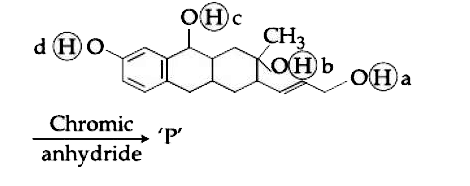Because of resonance the oxygen atom of -OH group of phenol
Acquires positive charge
Acquires negative charge
Remains uneffected
Liberates
The correct Answer is:C
To understand the effects of resonance on the oxygen atom of the -OH group in phenol, we can break down the explanation into a series of steps:
1. Identify the Structure of Phenol:
- Phenol consists of a benzene ring (C6H5) with a hydroxyl group (-OH) attached to it. The structure can be represented as follows:
OH∣C6H5
2. Draw the Resonance Structures:
- The resonance structures of phenol can be drawn by moving the electrons in the π-bonding system of the benzene ring and the lone pair of electrons on the oxygen atom.
- The first resonance structure can be drawn by moving the lone pair from the oxygen to form a double bond with the carbon atom of the benzene ring. This results in a positive charge on the oxygen atom:
O⁺∣∣C6H5
3. Continue Drawing Resonance Structures:
- The next step involves moving the double bond back to the oxygen and shifting the double bond in the benzene ring to another carbon atom. This will create another resonance structure with a different arrangement of charges:
O⁻∣C6H5
4. Identify Charge Distribution:
- Throughout the resonance structures, the oxygen atom can carry a positive charge in some structures and a negative charge in others. This indicates that the oxygen atom is involved in resonance, which stabilizes the molecule overall.
5. Conclude the Effect of Resonance:
- The resonance in phenol allows the -OH group to stabilize the molecule through delocalization of electrons. The presence of the -OH group increases the electron density on the benzene ring, making phenol more reactive than benzene itself.
Final Conclusion:
The oxygen atom in the -OH group of phenol participates in resonance, which leads to a distribution of charges across the molecule. This resonance contributes to the stability and reactivity of phenol.
- Phenol consists of a benzene ring (C6H5) with a hydroxyl group (-OH) attached to it. The structure can be represented as follows:
OH∣C6H5
- The resonance structures of phenol can be drawn by moving the electrons in the π-bonding system of the benzene ring and the lone pair of electrons on the oxygen atom.
- The first resonance structure can be drawn by moving the lone pair from the oxygen to form a double bond with the carbon atom of the benzene ring. This results in a positive charge on the oxygen atom:
O⁺∣∣C6H5
- The next step involves moving the double bond back to the oxygen and shifting the double bond in the benzene ring to another carbon atom. This will create another resonance structure with a different arrangement of charges:
O⁻∣C6H5
- Throughout the resonance structures, the oxygen atom can carry a positive charge in some structures and a negative charge in others. This indicates that the oxygen atom is involved in resonance, which stabilizes the molecule overall.
- The resonance in phenol allows the -OH group to stabilize the molecule through delocalization of electrons. The presence of the -OH group increases the electron density on the benzene ring, making phenol more reactive than benzene itself.
The oxygen atom in the -OH group of phenol participates in resonance, which leads to a distribution of charges across the molecule. This resonance contributes to the stability and reactivity of phenol.
Topper's Solved these Questions
- ALCOHOL, PHENOL AND ETHERBOOK - ERRORLESS CHAPTER - ALCOHOL, PHENOL AND ETHEREXERCISE - Ordinary thinking (Ojective questions) Uses of Alcohol, Phenol and Ethers
20 Videos
- ALCOHOL, PHENOL AND ETHERBOOK - ERRORLESS CHAPTER - ALCOHOL, PHENOL AND ETHEREXERCISE - Critical Thinking (Objective Questions)
17 Videos
- ALCOHOL, PHENOL AND ETHERBOOK - ERRORLESS CHAPTER - ALCOHOL, PHENOL AND ETHEREXERCISE - Ordinary thinking (Ojective questions) Preparation of Alcohol, Phenol and Ethers
46 Videos
- ALDEHYDES AND KETONES BOOK - ERRORLESS CHAPTER - ALDEHYDES AND KETONES EXERCISE - JEE Section (JEE (Advanced) 2018) Numeric answer type question
1 Video
Similar Questions
Knowledge Check
The OH group of phenol
Aactivates ring powerfully and direacts ortho, para in nucleophilic aromatic substitution.Bactivates ring powerully and direacts ortho, para in electrophilic substitutionCdeactivates powerfully and directs ortho, para in electrophile aromatic substitutionDdeactivates powerfully and directs meta in electrophilic aromatic substitution.What is formed when hydrogen atom of -OH group in phenol is replaced by −COCH3 group of acetyl chloride ?
Amethoxy benzeneBchloro benzeneCdiethyl etherDphenyl acetateAssertion (A) : Ethers are classified on the basis of alkyl groups attached to the oxygen atom.
Reason (R) : The presence of −OH group in phenols deactivates the aromatic ring towards electrophilic substitution.ABoth Assertion (A) and Reason (R) are correct statements, and Reason (R) is the correct explanation of the Assertion (A).BBoth Assertion (A) and Reason (R) are correct statements, but Reason (R) is not the correct explanationof the Assertion (A).CAssertion (A) is correct, but Reason (R) is incorrect statement.DAssertion (A) is incorrect, but Reason (R) is correct statement.
Which of the following process is suitable for replacing oxygen atom of carbonyl group by the hydrogen atoms ?
View Solution(A) Carboxylic acids ⎛⎜ ⎜⎝R−O∣∣C−OH⎞⎟ ⎟⎠ have a carbonyl group but it does not give the test of carbonyl group.
Due to resonance double, the bond character of group is greatly reduced.
group is greatly reduced.
View SolutionThe group obtained by the removal of H-atom of the -OH group of ROH is called
View SolutionSTATEMENT-1: Phenol is more reactive than benzene towards electrophilic substitution reaction.
and
STATEMENT-2: OH group of phenol is electron donating due to resonance.
View SolutionC(OH)4 is unstable because a carbon atom cannot hold more than one −OH groups but Si(OH)4 is a stable compound because
View Solution
